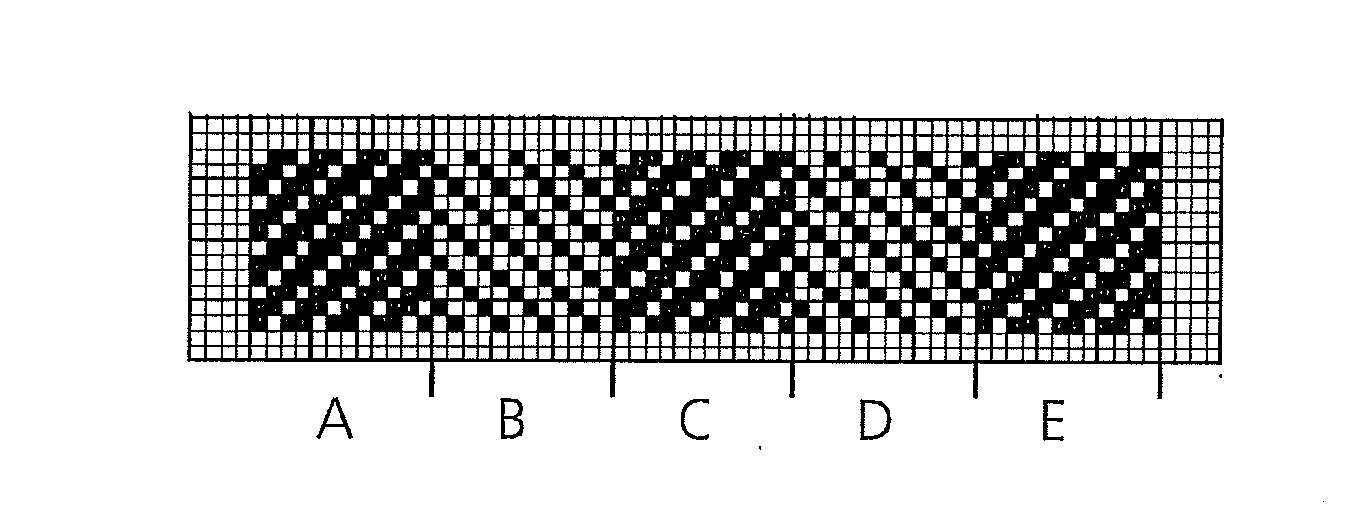Seat-belt strap for a seat-belt system
a seat belt and strap technology, applied in the field of seat belt straps for seat belt systems, can solve the problems of wavy straps, comparatively low thread strength in the field of seat belt straps, and the principle of thread deployment in the field of restraint systems must be considered problemati
- Summary
- Abstract
- Description
- Claims
- Application Information
AI Technical Summary
Benefits of technology
Problems solved by technology
Method used
Image
Examples
first embodiment
[0057]FIG. 2 depicts an example of the seat-belt strap 1 wherein the 1 / 2 twill weave and the 2 / 1 twill weave alternate after a specified number of repeats, in the present case after four repeats. As will be known, a repeat denotes the number of threads necessary to make the basic unit of a weave, i.e., the smallest number of warp and weft threads after which the pattern of interlacings repeats. In the illustrative example depicted in FIG. 2 each repeat has three warp threads 3. Following the first twelve warp threads 3, i.e., after four repeats, the weave changes from a 2 / 1 twill weave to a 1 / 2 twill weave. Therefore, in the region denoted “A”, where the woven fabric 2 has the 2 / 1 twill weave, there will be a greater number of warp threads 3 at the surface of the seat-belt strap 1 than in the “B” region, which follows on from the “A” region and where a 1 / 2 twill weave is provided. Altogether, five regions A, B, C, D and E are provided in the present case, with a 2 / 1 twill weave bein...
fourth embodiment
[0062]In the weave pattern diagram depicted in FIG. 5 for seat-belt strap 1, the interlacing of weft threads 4 changes in the longitudinal direction of woven fabric 2 as well as the interlacing of warp threads 3. Whereas the type of construction changes after altogether five repeats and hence at three warp threads 3 per repeat and after fifteen warp threads 3, the interlacing of weft threads changes after altogether six weft threads 4. As a result, seat-belt strap 1 acquires a diamond pattern. It will be appreciated that such a diamond pattern of seat-belt strap 1 would also be possible in other sizes provided the type of construction changes after a different number of warp threads 3 and / or weft threads 4. In the weave pattern diagram depicted in FIG. 5, an empty column was inserted for clarity between partial repeats in each case. FIG. 5 further reveals that the selvage regions of seat-belt strap 1 are constructed differently than the central region thereof, viz., with the alterna...
PUM
 Login to View More
Login to View More Abstract
Description
Claims
Application Information
 Login to View More
Login to View More - R&D
- Intellectual Property
- Life Sciences
- Materials
- Tech Scout
- Unparalleled Data Quality
- Higher Quality Content
- 60% Fewer Hallucinations
Browse by: Latest US Patents, China's latest patents, Technical Efficacy Thesaurus, Application Domain, Technology Topic, Popular Technical Reports.
© 2025 PatSnap. All rights reserved.Legal|Privacy policy|Modern Slavery Act Transparency Statement|Sitemap|About US| Contact US: help@patsnap.com



